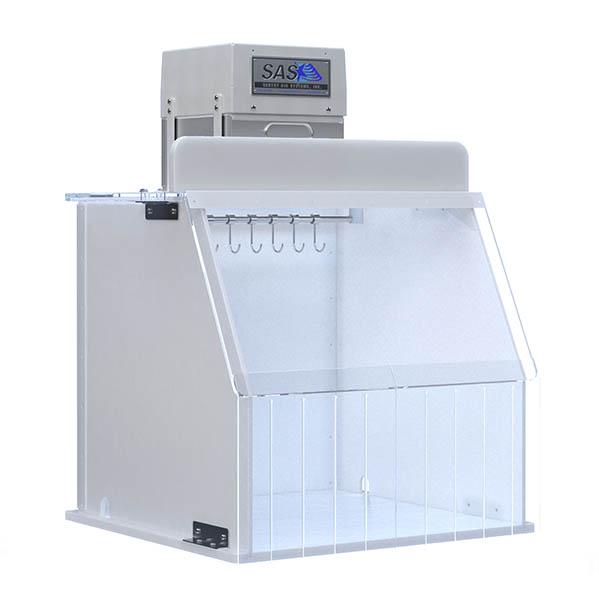IV Hood
IV Hoods, or vertical laminar flow hoods, provide a positive pressure enclosure to protect the product and users from cross-contamination of airborne particulate. IV Hoods supply reduced particulate air to the work space creating an ISO Class 5 cleanroom environment suitable for IV Bag preparation. Healthcare professionals should prepare IV bags in a sterile environment in order to produce the highest quality product as well as safeguard patients’ health and safety.
IV Hoods - Laminar Flow Cabinets
Laminar flow cabinets create a clean work enclosure for IV bag preparation through a positive pressure or vertical laminar flow pattern. A vertical laminar flow pattern forms when the system draws in ambient air through the dual stage filtration system supplying clean air to IV Hood. The dual stage filtration system contains a pre-filter and choice of the main filter – HEPA filter which offers up to 99.97% efficiency on particles down to 0.3 microns or ULPA filter which maintains up to 99.995% efficiency on particles down to 0.12 microns. The IV Hood features a stainless steel IV Bag rod for convenient and sterile temporary storage. Rods are available with 7 or 10 hooks.

Portable Clean Rooms
The Portable Clean Room is a compact positive pressure system designed to provide exceptionally clean laminar airflow inside the hood. This system utilizes a dual stage filtration process which consists of a MERV8 pre-filter and a HEPA filter with an efficiency rating up to 99.97% efficient on particles .3 micrometers and larger. For applications requiring a higher efficiency an ULPA filter is available with an efficiency rating of up to 99.9995% at .12 micrometers.
Traditionally, companies that desired a clean sterile work space would have to convert an entire room into a HEPA filtered positive pressure area, and end up spending tens of thousands of dollars and take up excess room. However, our portable clean rooms are designed to be cost saving, by offering a compact solution that requires very little space and as much mobility as needed.
IV Preparation
IV preparation entails compounding medication, vitamins, and supplements into an intravenous fluid to be supplied directly to the bloodstream. IV or infusion therapy has grown in popularity for outpatient services and offers immediate therapeutic responses to treat a variety of medical conditions.
To protect the product and patient, medical professionals must follow best practices for IV preparation. The FDA does not regulate IV bag preparation but suggests following the USP 797 guidelines. USP 797 specifies best practices as following aseptic techniques and utilizing a vertical laminar flow hood that furnishes ISO Class 5 clean air. IV Hoods, or laminar flow workstations, offer a solution for safe IV preparation.
ISO Class 5
| Particle Size | Maximum # of Particles |
| ≥ 0.1 µm | 100,000 |
| ≥ 0.2 µm | 23,700 |
| ≥ 0.3 µm | 10,200 |
| ≥ 0.5 µm | 3,520 |
IV Hoods, or Laminar Flow Clean Benches, provide an ISO Class 5 environment. In order to meet ISO Class 5 standards, the filtration system must meet strict limits on the maximum number of particles sized 0.1 to 0.5 microns per cubic feet in the air. The number of particles must be limited to ensure a clean and hygienic work surface for IV bag infusion or preparation. The ISO standard limits on particles for an ISO Class 5 cleanroom are detailed in the table.
Laminar Flow Hood Cleaning
To properly clean the IV Hood, USP 797 describes a detailed cleaning, disinfecting, and applying a sporicidal agent to the hood as well as nearby surfaces. Operators should follow the outlined steps below to properly prevent contamination to the IV Hood.
- Clean – First, wipe down the hood with sterile water and low-lint wipers. Then, in order to remove residue, dirt, and debris, operators must use a cleaning agent on all surfaces of the interior of the hood.
- Disinfect – Remove fungi, viruses, and bacteria with a sterile disinfectant such as sterile 70% IPA.
- Dry – Allow surfaces to air dry fully before beginning compounding procedures.
All surfaces in the IV Hood must be cleaned and disinfected at the beginning and end of shifts as well as when contamination is suspected. However, the horizontal work surface in an IV hood must be cleaned and disinfected every 30 minutes or in between compounding activities, if one compounding activity takes longer than 30 minutes.
Other surfaces near the IV Hood should be cleaned on a schedule to prevent contamination. Sinks, pass-through chambers, areas outside of the hood, and floors need to be cleaned and disinfected daily. However, the walls, doors, door frames, ceilings, storage bins, and shelving only need to be cleaned and disinfected monthly.
For all surfaces, including inside the IV Hood, a sporicidal agent must be applied on a monthly basis to remove bacterial and fungal spores.
Surface Sampling
Monthly surface sampling helps check for proper cleaning and disinfecting methods. Sampling is taken after compounding but before cleaning the areas. Areas to sample include interior of the hood, area near the hood, equipment in the hood, frequently touched areas, and pass-through chambers. After sampling, areas need to be cleaned and disinfected.

 Made in the USA
Made in the USA